At ReviewTrackers, our proprietary natural language processing (NLP) engine provides valuable sentiment analysis and customer experience analytics on consumer reviews so business owners can make informed decisions in order to attract customers and grow revenue.
What is NLP?
NLP is the process by which machines can better understand large amounts of human language and extract meaning and insights from that data.
What is Sentiment Analysis?
Sentiment analysis organizes data into positive, negative, or neutral categories that provide additional context to the data. Here’s an example of it in action from the ReviewTrackers platform:
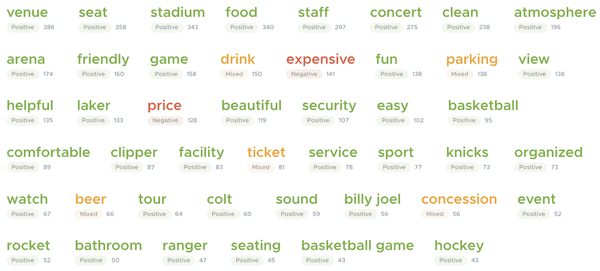
We initially showed off the power of our engine when it “read” and analyzed the sentiment of Stephen King’s The Shining throughout the book – successfully tracking the plot through positive and negative instances. In other words, the engine tracked specific keywords throughout the book and correctly analyzed its sentiment as the horrors unfolded in the story
Instead of giving our engine another horror book to read, we gave it something to analyze on a grander scale. A very buzzworthy collegiate basketball tournament is on the horizon, and in preparation, we had our NLP engine analyze and extract trends from a large quantity of consumer reviews on arenas – specifically the venues for the final nail-biting rounds of the tournament.
March 26 – 29, 2020
- Lucas Oil Stadium (Indianapolis, IN)
- Staples Center (Los Angeles, CA)
- Toyota Center (Houston, TX)
- Madison Square Garden (New York, NY)
April 4 – 6, 2020
- Mercedes-Benz Stadium (Atlanta, GA)
The first step to gathering data was to conduct sentiment analysis on customer review keywords. Here’s what it looks like on ReviewTrackers:
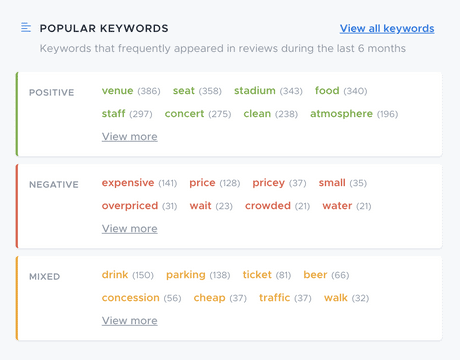
The Big Picture
To make sense of the data across all arenas, our NLP engine organized the reviews across 5 major categories and compared the overall positive and negative customer review sentiments for all venues. These reviews cover the main categories of:
- Atmosphere – amenities, seating, overall physical features
- Consumer – reasons why they are going to the venue, e.g. concert, tours, basketball
- Service – operations, staff
- Food – quality, options, types
- Value – cost
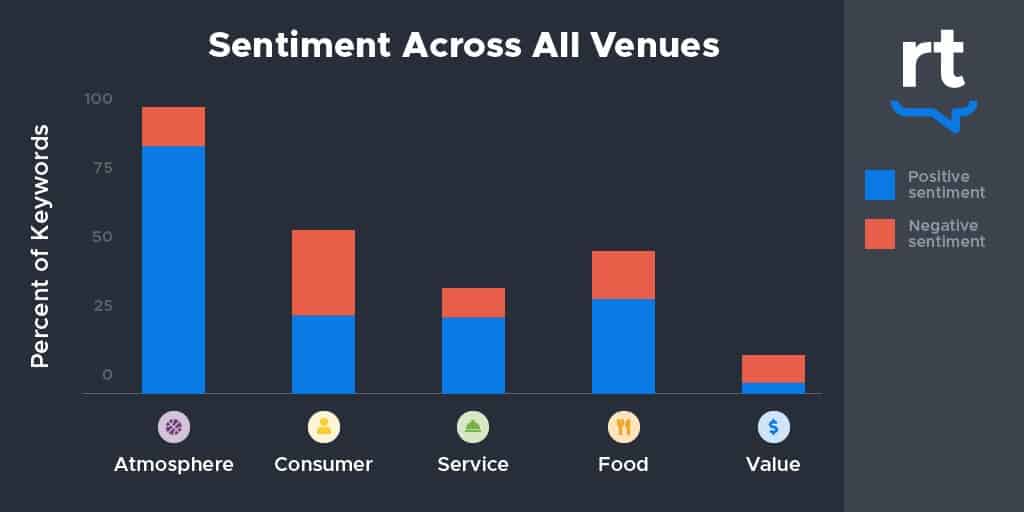
At a glance, it’s easy to see why these places may have been picked to host the final rounds of the tournament. The overwhelming positive sentiment about the atmosphere shows that the intensity of the games played at these arenas makes them much more exciting to watch in person.
The atmosphere literally comes at a cost, though. The overall value of visiting these venues has the smallest portion of positive sentiment, so it may be an exhilarating experience to watch a college basketball game at one of these venues, but you’ll have to pay a pretty penny to see it live.
However, not all venues are created equal. To see which arenas excelled across the varying categories, we need to take a closer look at the data.
The Matchup
A closer look at each arena’s performance across each category reveals interesting insights about consumer sentiments for each venue.
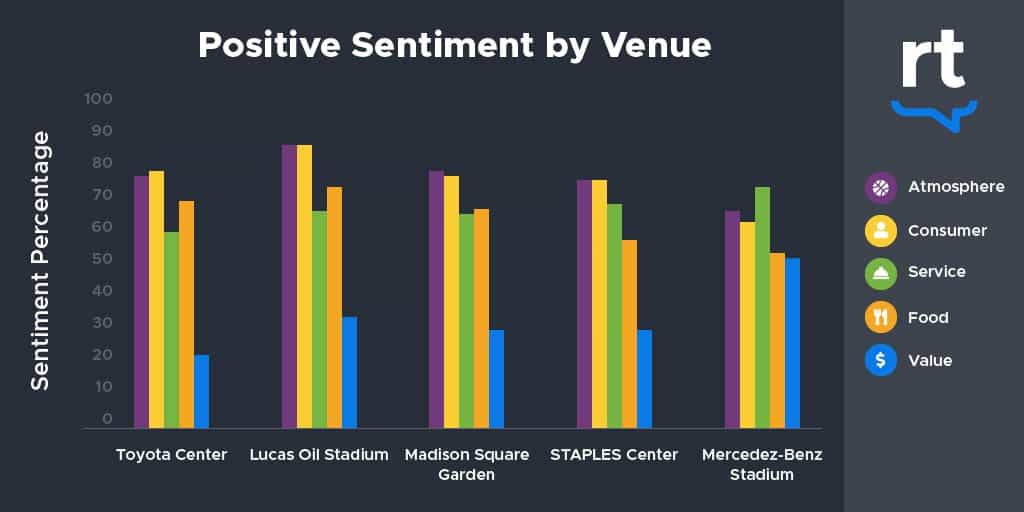
Take Lucas Oil Stadium for instance. In terms of positive sentiment, it beats the rest in the atmosphere and consumer categories. This could be due to a number of factors, such as the fact that its original purpose is to house the Indianapolis Colts football team, and that it also plays host to other events that come to Indiana’s capital, such as motorbike races and soccer matches.
The ability to host multiple events in a large stadium primarily used for football also means that Lucas Oil Stadium houses more seats (70,000 seats for basketball games) than other arenas like the Staples Center (19,079) and Madison Square Garden (19,812). More people means more noise, which could make Lucas Oil Stadium an electrifying place for two collegiate basketball teams playing against each other while students, faculty, and alumni cheer them on from the stands.
Another interesting dataset is the relationship between the food and value categories. Atlanta’s Mercedes-Benz Stadium received the highest positive sentiment for the two categories compared to other stadiums. Further research shows that the stadium recently cut prices twice on popular food items over the last two years, which makes the experience of attending an event there more positive due to increased affordability.
Instant Replay
By changing our perspective of the data and comparing the categories against each other, we get even more interesting insights about the consumers’ sentiment of each arena.
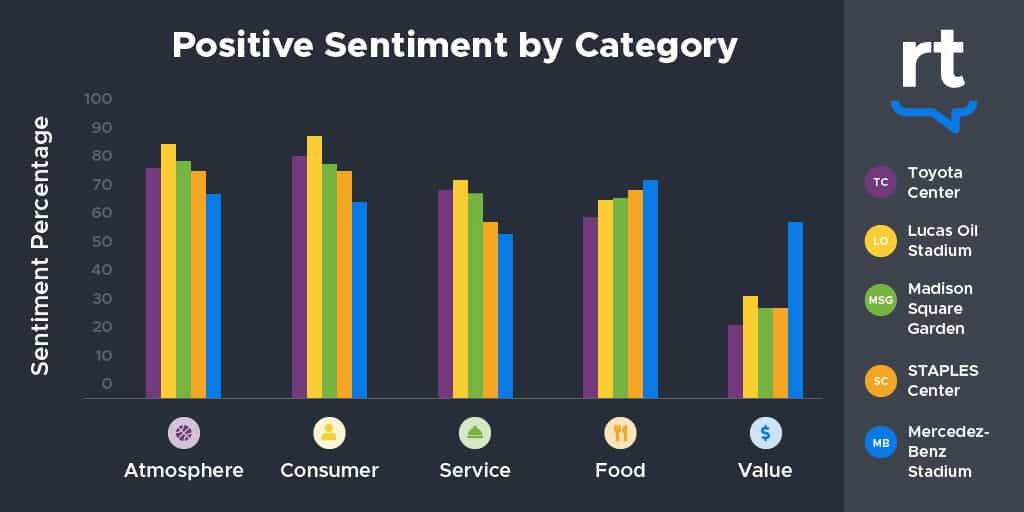
- Value: The value category has the lowest amount of positive sentiment across each venue, and understandably so. Attending sporting events, especially in the later stages of a high-profile tournament, can be expensive.
- Food: Despite the absence of positive sentiment surrounding value it still seems that consumers are still willing to enjoy the food, which has high marks across each stadium.
- Value + Food: Another interesting insight is the similarity in trend when you compare food and value – in most cases, there seems to be a correlation of the two (less positive sentiment toward value seems to also show less positive sentiment toward food, with the reverse also being true.
- Value + Service + Atmosphere: The relationship between the value, service, and atmosphere categories shows another correlation – an arena with a higher positive sentiment in value gets less positive sentiment towards service and atmosphere. In other words, you get what you pay for.
Enjoy The Game
There isn’t necessarily one decisive winner in this mini-bracket of ours, but there are insights to take away from each venue. Those watching at Lucas Oil Stadium are in for a treat due to the arena’s overall high marks for atmosphere, in addition to catering to consumer needs.
While there’s a certain allure to attending a basketball game at well-known places like the Staples Center and Madison Square Garden, it seems that it’s not worth the price of admission, especially if the service is seen in a negative light. Despite the high positive consumer sentiment, it seems that Houston’s Toyota Center is also not worth its value. Worse still is that attendees are not a fan of the arena’s food offerings.
It seems, then, that Mercedes-Benz Stadium is the best choice as the venue for the championship game. Attendees might not have as rich of an atmosphere or consumer experience, but it provides the most bang for your buck, not to mention food prices so low you can go back to the concession stand for seconds or thirds while enjoying some of the most intense basketball that the nation’s best colleges have to offer.